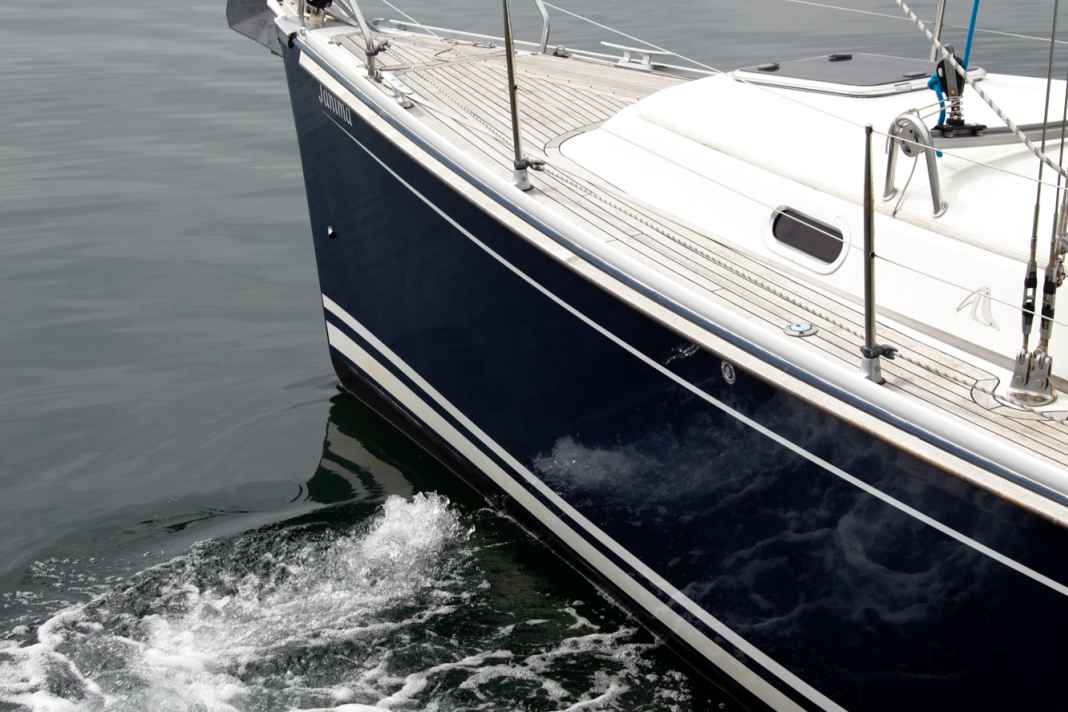


The point of a bow thruster is open to debate. It polarises just as much as electric winches, mainsail furling systems or electro-hydraulically folding bathing platforms. For some, they are the death of all seamanship, slowing the boat down in light winds and annoying. For others, a transverse thruster, as it is correctly called, is a helpful, modern addition to the equipment.
Both sides are probably right, to a certain extent. Because of course bow thrusters make some manoeuvres easier. But this can also mean that it is no longer possible to manoeuvre without one. And some models are indeed extremely loud. But bow thrusters are certainly no longer a thing of the past. On the contrary, new applications are even being devised. This is demonstrated by projects such as Dock & Go, in which the thruster on the bow works together with a rotating main propeller.
On the subject:
- Installing the bow thruster yourself - no witchcraft
- weak point of the bow thruster: Two accidents
- Test: Creating with a joystick. Dock & Go in practice
- Harbour manoeuvres: lying safely and calmly alongside in the packet
- Locks: What you should bear in mind when the gates close
- Harbour manoeuvres: 10 tips for leaving port safely with a sailing boat
In the charter sector, bow thrusters are almost standard; entire fleets are being retrofitted or ordered with bow thrusters. And owners, especially couples or single-handed sailors, are also increasingly hearing the suspicious rattling under the hull.
That's why some bow thrusters are loud
In fact, it is above all this noise that causes the most controversy. Because some yachts are more likely to be heard than seen when they are steered with the crossbeam instead of the rudder right from the harbour entrance. This is not only pointless, it also borders on harassment.
The annoying noises are caused by design constraints. The propeller diameter should be small in order to minimise the installation dimensions, but at the same time generate high thrust. This requires high speeds and special propeller geometries. These circumstances lead to cavitation on the propeller blades. The cavitation bubbles explode on the walls of the propeller housing and cause a loud bang. This "works" very well with tunnel systems, as the propeller cavitates particularly strongly there and the tube also acts as an amplifier.
Newcomers to a yacht, especially charterers, should make sure they know what kind of bow thruster they are dealing with while still in harbour. In the case of a tunnel system, it can always be assumed that a significant amount of noise will be generated. In addition to this initial check, there are other measures that need to be taken to prepare for the cruise, such as studying the manual and operating instructions, and not just when the mooring is imminent. Otherwise, it is almost inevitable that things will get hectic - the best prerequisite for collisions and damage.
Familiarise yourself with the system
When familiarising yourself with the system, it is very important to know where and how to switch it on. Sometimes the On button has to be pressed for a few seconds. Actually, the operation itself is usually intuitive, whether using a joystick or buttons. However, if the panel has been mounted lengthways to the direction of travel, for example on the side of the steering column or next to the engine panel, for space reasons, this can lead to confusion. In this case, there is no left or right button, only a red and a green one.
So feel free to try out the system in the harbour at the mooring - it doesn't have to be at the most beautiful hour at sunset, and a short push to each side is enough. If you use it for longer periods at the mooring, you risk being suspected of using the propeller as a faeces whisk to disperse the cloud from the tank, which unfortunately happens occasionally.
If the bow can be reached from land, for example when mooring in the box or alongside, you can try to push the hull against the thrust of the thruster by hand from the outside to get an idea of the thrust force. This is because a propeller that has been in the water for a whole season can be heavily overgrown with mussels and pockmarks. However, even the slightest growth leads to a significant loss of thrust.
It is also important what the jet produced looks like. If it contains a lot of air and intake noises can be heard, there is probably a lack of installation depth. This is a particular problem with tunnelling systems in modern, flat hulls. In this case, it can help to send two or three crew members to the foredeck during the manoeuvre so that it sinks a little deeper. The beam also provides information about the position of the propeller. The further back it is, the worse the effect is likely to be.
Bow thruster is not an insurance policy
More extensive tests should follow outside the harbour. To do this, lay the yacht at right angles to the wind and try to push the bow against the wind, provided it is blowing. This gives the best indication of performance. But even in calm conditions, it is important to develop a feeling for how the thrust and the mass of the boat relate to each other.
Bow thruster users are considered bad skippers. They are accused of no longer being able to master conventional manoeuvres with rudder and lines. This is probably due to the fact that the propeller in the bow is often used even when it is not necessary. However, we have listed some manoeuvres for which it does make sense following. This also includes casting off in crosswinds, where the beam can counteract the drift as long as there is no speed in the ship.
In principle, however, the cross-current system should only be seen as an aid and should not be included in the manoeuvre planning. This is because if it does not work, it is almost impossible to correct the feeder or feeder. All it takes is overheating, which can quickly occur during continuous operation and cause the fuse to blow. Therefore, only ever work with short bursts, make corrections and do not perform the manoeuvre yourself with the spotlight. Also find out beforehand where the fuse switch is located!
Some systems also switch off automatically if they are not used for a certain period of time. This function, which actually makes sense because otherwise switching off at the start of a trip would often be forgotten, can be disastrous. Because after a long period of manoeuvring around looking for a berth, nothing happens at the crucial moment.
So if you have a bow thruster, you should use it carefully. It is a modern aid, especially for the modern yachts that are being driven around a lot. But you shouldn't become dependent on it.
How a bow thruster works
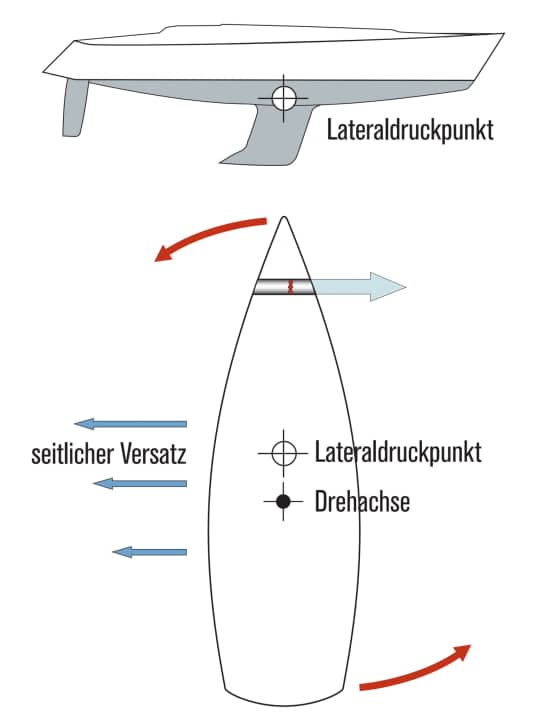
A bow thruster generates a transverse force through its thrust. It initially moves the yacht sideways. However, due to the relatively large lateral surface area of sailing boats, this lateral movement is opposed by a large resistance. Since a force only acts on the bow, a torque is generated - the yacht moves around its axis of rotation. Its position results from the thrust force and the distance of the bow thruster from the lateral pressure point. The further away the bow thruster is from the lateral pressure point, the closer the axis of rotation is to it. On modern yachts with a split lateral plan, it is usually level with the keel. However, it is not only the bow that turns, but also the stern, and in the opposite direction! This is particularly important when manoeuvring alongside.
The further forward, the more power
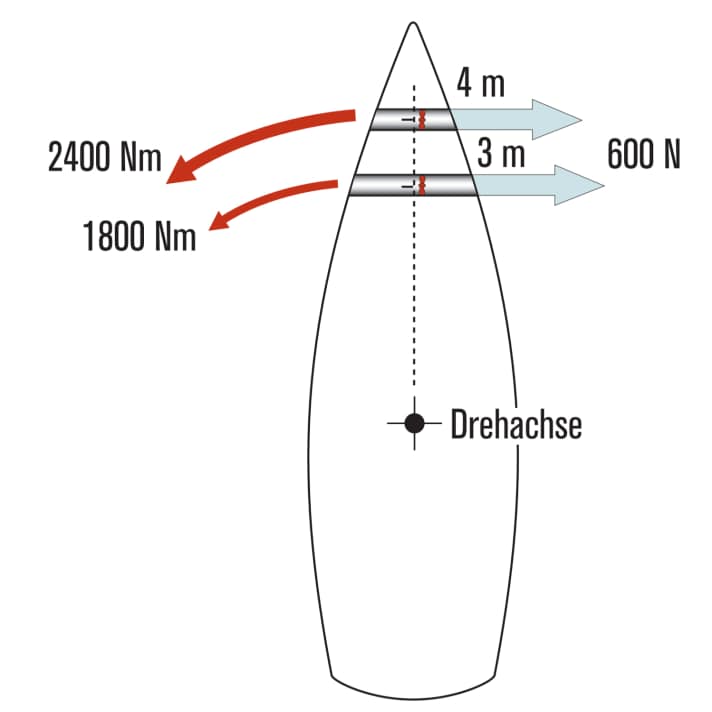
Two factors are decisive for the strength of the torque, i.e. the resulting lateral force at the bow: the power of the bow thruster and its distance from the lateral pressure point. The further forward it is installed, the longer the lever arm and the greater the resulting torque.
In the - highly simplified - example, a bow thruster with an output of 600 newtons, comparable to 60 kilograms of thrust, was used as the basis for a ten-metre yacht. Installation at a distance of three metres from the axis of rotation would result in a torque of 1,800 Newton metres. If the same bow thruster were installed just one metre further forward, the extended lever would generate 600 Newton metres more torque. A system with an output of just 450 newton metres could then be installed. Depending on the size of the boat, this may make up the difference in price between a tunnel and a folding system.
The more speed ahead, the less effective
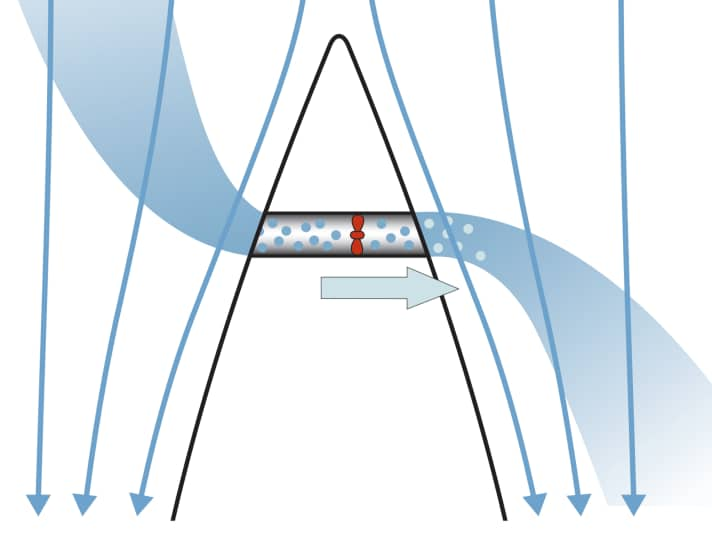
A bow thruster only achieves its full power when the yacht is stationary. At a speed of just two knots ahead, it is reduced by around half, and from a speed of five knots the system is ineffective. This is due to several factors. Firstly, the water that is sucked in is swirled by the speed, and the propeller cavitates earlier in this turbulent current. In addition, the flow around the hull, keel and rudder creates hydrodynamic lift, which keeps the yacht on course.
In short: a yacht that sails does not drift athwartships. The transverse thruster is increasingly powerless against this stabilising force as the speed increases. Overall, the hydrodynamic influences cause the axis of rotation to shift further and further forwards until the torque approaches zero.
Four manoeuvres with bow thruster
Traverse
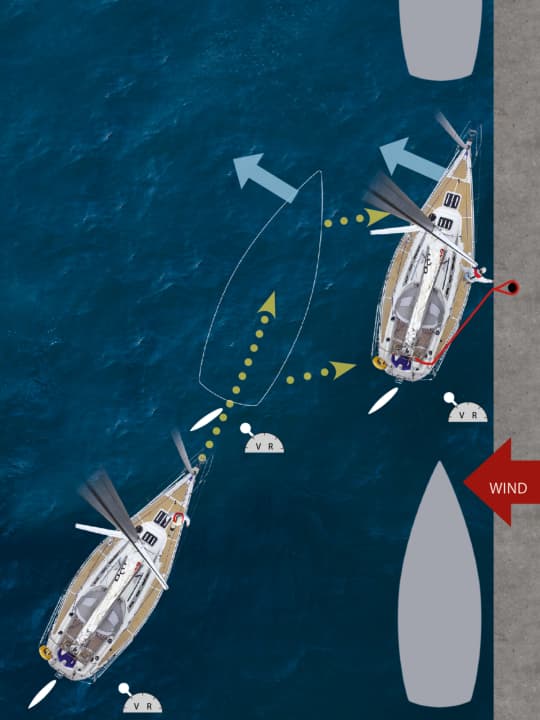
It is possible to moor crossways, but there must not be too much wind offshore. Move the yacht slightly aft and parallel to the berth. Use the bow thruster to push the bow towards the shore (blue arrows), while at the same time counteracting the turning momentum at the stern by pushing slightly forwards and steering away from the shore. In this way, the yacht drifts sideways, slightly ahead.
With the rear against

To counteract the wind vane effect, a pier can be approached with the stern against the wind. As soon as a mooring line has been taken aft, use the transverse thruster to counteract the displacement of the bow, but only then! Before that, its use would move the stern away from the pier. If the bow thruster is too weak in strong winds, it can be assisted by a strong thrust ahead. Even simpler would be steaming into a centre spring.
Turning aid

In very narrow lanes between piles or mooring lines, it can be very difficult to manoeuvre the bow through strong winds. Then the lack of manoeuvring space forces you to stop and the bow drifts away. Instead of mooring to a pole upwind and waiting for the boat to swing round, the bow can be pushed through the wind with extra thrust. The tack can then be completed easily.
Direction correction
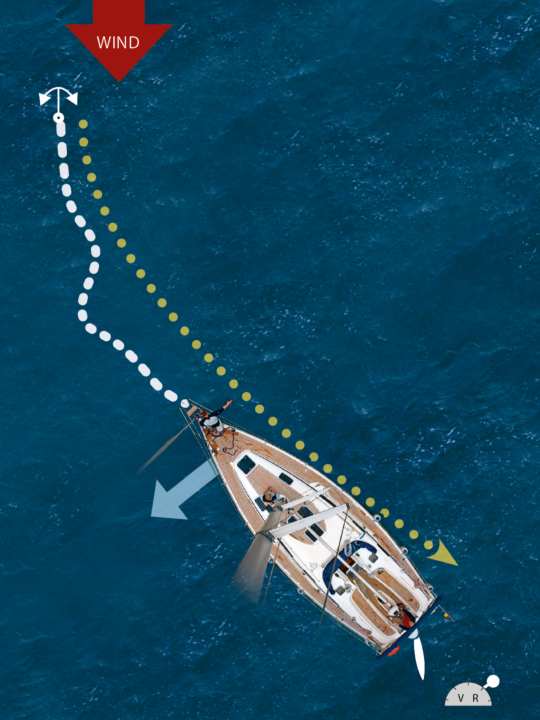
When there is a lot of wind at the start of an anchor manoeuvre, there is a high risk of the yacht drifting. Without speed in the ship, it is unable to manoeuvre at the moment of dropping and quickly embarks on an unwanted journey to leeward. However, the bow can be kept in the wind by making short pushes in good time until there is enough chain to stabilise the drift direction.
Bow thruster systems in comparison
Tunnel system
![DEU;DE;GERMANY;DEUTSCHLAND;ALLEMAGNE, Schleswig-Holstein, Heiligenhafen, Baltic Sea bow thruster. Conventional bow thruster from VETUS with tunnel through the hull and bow thruster bolted under the hull.
Test boats: HANSE 341 and HANSE 342 [ (c) Klaus Andrews, Pferdeweide 1, D-22589 Hamburg, Germany, Tel. +49-40-88 30 50 44, Mobil 0171 / 413 31 20, www.KlausAndrews.com, mail@KlausAndrews.com, account no. 1268491444, BLZ 200 505 50, HASPA. IBAN: DE59 2005 0550 1268 4914 44 BIC HASPDEHHXX, www.freelens.com/clearing, Any use only against payment of a fee, copyright notice and receipt; if the photo is used for purposes other than journalism, please contact the photographer. No modelrelease! ][#0,121#]](https://media.delius-klasing.de/dk-wassersport/images/dpr_auto,fl_progressive,f_auto,c_fill,h_475,w_712/q_auto:eco/yacht/994407-20100609d073_f66ec8e19474c1e692f587a47f693da9/deu-de-germany-deutschland-allemagne-schleswig-holstein-heiligenhafen-baltic-sea-bow-thruster-conventional-bow-thruster-from-vetus-with-tunnel-through-the-hull-and-bow-thruster-bolted-under-the-hull-test-boats-hanse-341-and-hanse-342-c-klaus-andrews-pferdeweide-1-d-22589-hamburg-germany-tel-49-40-88-30-50-44-mobil-0171-413-31-20-www-klausandrews-com-mail-klausandrews-com-account-no-1268491444-blz-200-505-50-haspa-iban-de59-2005-0550-1268-4914-44-bic-haspdehhxx-www-freelens-com-clearing-any-use-only-against-payment-of-a-fee-copyright-notice-and-receipt-if-the-photo-is-used-for-purposes-other-than-journalism-please-contact-the-photographer-no-modelrelease-0-121-)
Simple system, few mechanics, favourable price, therefore installed on many boats and especially charter yachts. Hardly susceptible to damage. Installation is not complicated and can be done by yourself. Positioning is sometimes problematic. Particularly with U-shaped foreship frames, as on modern yachts, the tunnel must be moved far aft to ensure a distance of one tunnel diameter from the waterline. The short lever results in a loss of torque. In addition, the ratio of tunnel diameter to length can become unfavourable and the increasing dynamic pressure can lead to a loss of power. Tunnel systems favour noise due to cavitation. They are also susceptible to fouling due to their permanently submerged state. The hole in the hull also creates increased resistance. Depending on whether it has been designed to be flow-optimised with a pre-bulge and drainage channel, this can result in a loss of between one and five percent.
Underbuilt
![DEU;DE;GERMANY;DEUTSCHLAND;ALLEMAGNE, Schleswig-Holstein, Heiligenhafen, Baltic Sea bow thruster. Conventional bow thruster from VETUS with tunnel through the hull and bow thruster bolted under the hull.
Test boats: HANSE 341 and HANSE 342 [ (c) Klaus Andrews, Pferdeweide 1, D-22589 Hamburg, Germany, Tel. +49-40-88 30 50 44, Mobil 0171 / 413 31 20, www.KlausAndrews.com, mail@KlausAndrews.com, account no. 1268491444, BLZ 200 505 50, HASPA. IBAN: DE59 2005 0550 1268 4914 44 BIC HASPDEHHXX, www.freelens.com/clearing, Any use only against payment of a fee, copyright notice and receipt; if the photo is used for purposes other than journalism, please contact the photographer. No modelrelease! ][#0,121#]](https://media.delius-klasing.de/dk-wassersport/images/dpr_auto,fl_progressive,f_auto,c_fill,h_475,w_712/q_auto:eco/yacht/994400-20100609d033_152aa835e1418120dbb64322b80a841f/deu-de-germany-deutschland-allemagne-schleswig-holstein-heiligenhafen-baltic-sea-bow-thruster-conventional-bow-thruster-from-vetus-with-tunnel-through-the-hull-and-bow-thruster-bolted-under-the-hull-test-boats-hanse-341-and-hanse-342-c-klaus-andrews-pferdeweide-1-d-22589-hamburg-germany-tel-49-40-88-30-50-44-mobil-0171-413-31-20-www-klausandrews-com-mail-klausandrews-com-account-no-1268491444-blz-200-505-50-haspa-iban-de59-2005-0550-1268-4914-44-bic-haspdehhxx-www-freelens-com-clearing-any-use-only-against-payment-of-a-fee-copyright-notice-and-receipt-if-the-photo-is-used-for-purposes-other-than-journalism-please-contact-the-photographer-no-modelrelease-0-121-)
The most obvious advantage of the under-mounted Exturn bow thruster from Austrian manufacturer Marinno is the minimal intervention in the hull structure. Only a 50-millimetre hole needs to be drilled, eliminating the need for time-consuming sawing and laminating work. The drive and propeller are housed in a streamlined casing. This allows the system to be positioned far forward, for example under a water tank in the foredeck. This provides very good leverage. Exturn is priced at around 4,000 euros for a ten-metre yacht. However, as there are hardly any installation costs, the system is the cheapest overall. Other advantages are the low noise level and the long running time thanks to the cooling of the surrounding water. However, the exposed position also has disadvantages, as the bow thruster is unprotected if it falls dry. It also causes increased resistance, which according to the manufacturer should be in the range of a tunnelling system. And the Exturn is also susceptible to fouling.
Fold-out
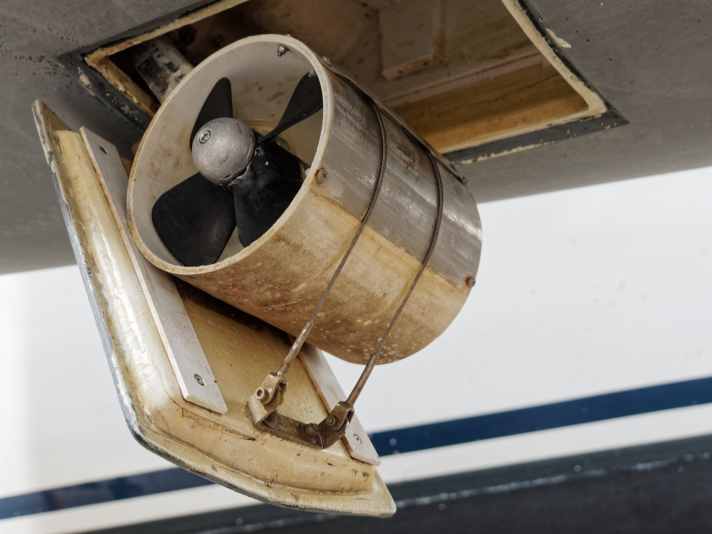
The most complex bow thruster installation, but also the one with the least resistance. The flow around the hull is not disturbed when the system is retracted. As the propeller folds out of the bottom of the hull, it still reaches sufficient water depth to remain effective even when installed far forward and with shallow bulkheads, so long levers are possible. The short tunnel also minimises cavitation noise. This system is best protected against fouling, as the infrequent extension means that few organisms and nutrients enter the shaft. The mechanism for extending the tunnel is the Achilles heel of this system. It is complicated and therefore potentially prone to errors. These systems are also among the most expensive. The parts alone cost around 5,500 euros for a ten-metre yacht, plus an additional 2,000 euros for installation, which is no easy task.

